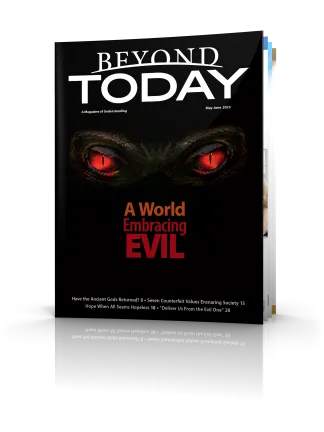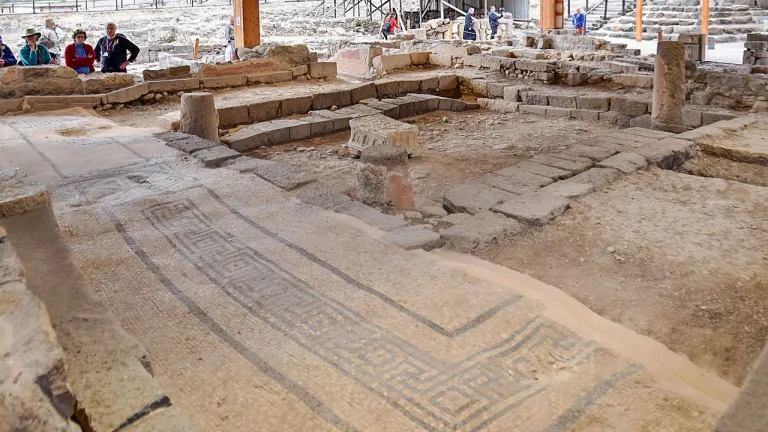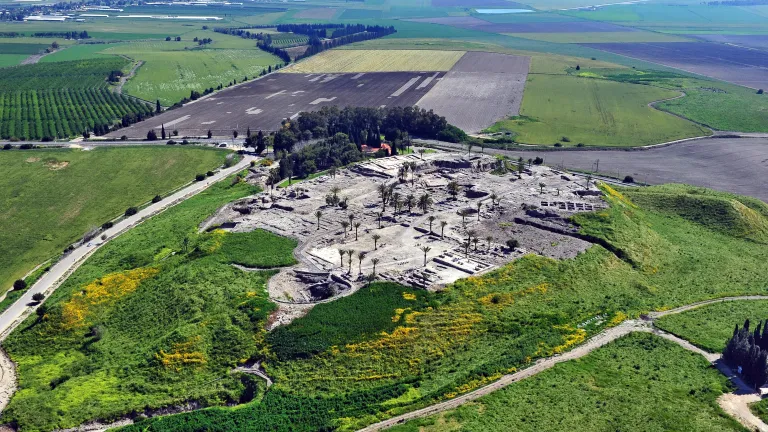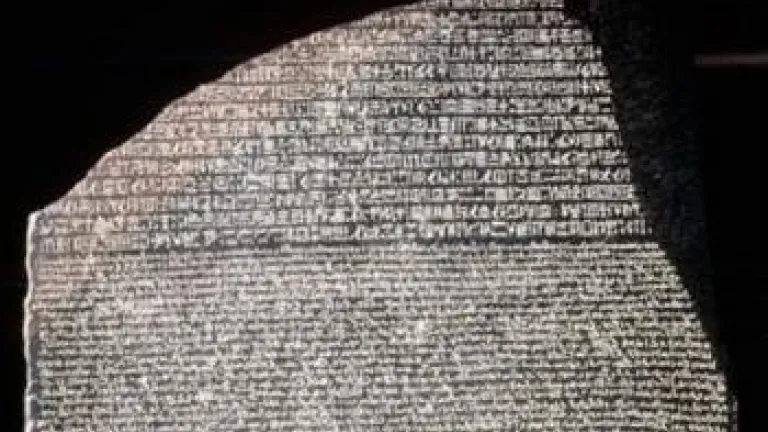More Proof of the Bible: Mount Ebal Discoveries

Recent archaeological findings regarding an altar and curse tablet corroborate the Bible’s record of the Israelites’ entry into the Holy Land as a people in covenant with God.
The Bible is not, as some believe, a collection of myths that we need not take seriously. It claims to be the inspired Word of God—presenting the story of God and His relationship with those He’s created. But should we accept this claim?
The veracity of Scripture can be shown through many avenues. One is the discoveries of archaeology. Time and time again, they confirm the accuracy of the biblical record. Not so many years ago scholars doubted the story of the Israelite journey out of Egypt or the life of King David of Israel. However, archaeological discoveries have greatly substantiated these biblical accounts—plus hundreds more.
Ongoing findings continue to strengthen belief in the Bible. And now, just in the past two years, a significant discovery has been made at the site of Mount Ebal in the land of Israel—the recognition of an altar dating to the time of Joshua and an associated curse tablet.
Blessings and cursings
Mount Ebal and neighboring Mount Gerizim are situated on opposite sides of a valley in which once sat the ancient town of Shechem (now the city of Nablus). The two mountains are known in Scripture as the mountains of “cursing” and “blessing,” respectively.
Significantly, Shechem was the place where God first repeated his promises to the patriarch Abraham when he moved to the Promised Land. And Abram built an altar in Shechem (Genesis 12:6–7).
Centuries later, as God instructed the Israelites through Moses in Deuteronomy 11 and 27-28, after crossing the Jordan River and starting to take possession of the Promised Land, they were to go to the same area and build an altar on Ebal of whole stones not shaped with iron tools, set up memorial stones with the Book of the Law written on them, and perform a ceremony involving all the tribes.
Half the tribes were to gather on the slopes of Mount Gerizim for the proclamation of blessings for obedience to God’s laws, while the other half would gather on Mount Ebal for the announcement of curses for particular disobedience. The Levites would loudly declare these and the people would responsively shout “Amen,” with all the people hearing back and forth across the valley.
Joshua 8 records that the Israelites did just that when they started taking over the Holy Land under Joshua. Offerings were given at the Mount Ebal altar and the Book of the Law was read, including the blessings and cursings.
Did this really happen, or is this a biblical fable?
Identifying Joshua’s altar
Remarkably, the altar at Mount Ebal has been excavated, with evidence pointing to it being the one described in Scripture. A larger altar was eventually built on top of it, apparently as a memorial altar enclosing the earlier one.
Archaeologist Scott Stripling has done major study at this altar site, following on the work of earlier Israeli archaeologists. The larger rectangular altar from a later period garnered the most attention from previous archaeologists, as that fits the later time frame in which many put the Israelites’ arrival.
However, the smaller, circular structure underneath most interested Dr. Stripling. Six feet in diameter, it sits under the exact center of the rectangular altar, and its stones are whole and not shaped by iron tools, in accordance with the biblical passages cited. It’s dated back to the earlier time frame conservative biblical scholars recognize for the Exodus and conquest—around 1400 B.C.
The larger altar above it is dated. And Stripling believes this more recent altar belonged to the middle of the Judges period.
Stripling explains: “I think the round altar is actually Joshua’s altar. The rectangular one, which everybody is in love with, is a memorial altar that is protecting the real valuable one that is beneath it . . . Which makes sense because the Bible doesn’t suggest that there was ongoing ceremony on Mount Ebal, just that the altar was built for that ceremony. I have determined that the earlier pottery is from what we would call Late Bronze 1B–Late Bronze 2A horizon, so around 1400 BC, which of course fits very nicely with the biblical date” (quoted by Steve Law, “Ancient Hebrew Writing on Tablet Discovered at Joshua’s Altar,” Patterns of Evidence, Feb. 4, 2022).
Curse tablet amulet found at the site
Not only does it appear that Joshua’s altar has been found, but now a tiny lead tablet has been uncovered along with it to strengthen the identification. It matches a category of finds known to archaeology as curse tablets. Why might such an artifact be located at the Mount Ebal altar? Could it have something to do with Mount Ebal as the mountain of cursing?
When Dr. Stripling tried to open the folded, one-inch-square lead tablet, it started to break. So it was submitted to x-ray scanning. The scans revealed that inside is early Hebrew writing inscribed with a tiny stylus.
Such etching with a stylus is mentioned in Job 19:23-24: “Oh, that my words were recorded, that they were written on a scroll, that they were inscribed with an iron tool on lead, or engraved in rock forever!” (New International Version, emphasis added throughout).
YHW, a shorter form of the divine name YHWH or Yahweh, appears on the scan (reading Hebrew from right to left). In the 23-word English translation of the inscription, the word “curse” appears 10 times, and “YHW” appears twice. The full text reads:
“Cursed, cursed, cursed—cursed by the God YWH.
“You will die cursed.
“Cursed you will surely die.
“Cursed by YWH—cursed, cursed, cursed.”
(Some faint writing on the outside of the amulet has yet to be scanned and deciphered.)
This wording may well echo the cursings we find for disobedience that were proclaimed at Mount Ebal.
Dr. Stripling surmises that this tablet was an official component of the blessings and cursings ceremony and the offerings presented here, though that’s not specified in Scripture.
Another possibility may be that this was an attempted magical curse performed here in the early Judges period —with the location chosen because of the cursing association with Mount Ebal. The outside writing, if or when it's deciphered, might provide more clues.
Either way, the find connects Mount Ebal and the threat of cursing from Yahweh at the time of the Israelite conquest, helping to substantiate the biblical account.
The Bible: fact, not fable
Again and again, the Bible is vindicated in its recording of not myth, but fact and history! Here we have corroborating evidence for what’s stated in Deuteronomy and Joshua about the altar and cursing pronouncement at Mount Ebal at the time of the Israelite conquest.
It substantiates the reality of Israel’s covenant relationship with God and the need to continue in obedience to Him. We would do well to consider the importance of keeping covenant with God in our own lives today.
Moreover, we are reminded of what Jesus Christ prayed to His Father the night before His crucifixion: “Your word is truth” (John 17:17). A few months earlier He declared that “the Scripture cannot be broken” (John 10:35).
Yes, the biblical accounts are completely reliable. Archaeologists regularly find artifacts and other evidence that verify the accuracy of the Bible, and even shed additional light on what life was like in biblical times.
In the words of Scott Stripling: “After 150 years of archaeology in Israel, hundreds of synchronisms [aligning connections] between the material culture and the biblical text have been established. At this point, it takes more faith to believe that the Bible is not true than to believe that it is true” (biblearchaeologyreport.com/about).
The archaeological record verifies time and time again how the biblical stories are accurate and truly happened. But we are not to look on with mere superficial interest. The Bible is God’s book for us to come to know and trust Him and to teach us His ways and lead us to our destiny. Learn what He has here to reveal to you—and let it change your life!






